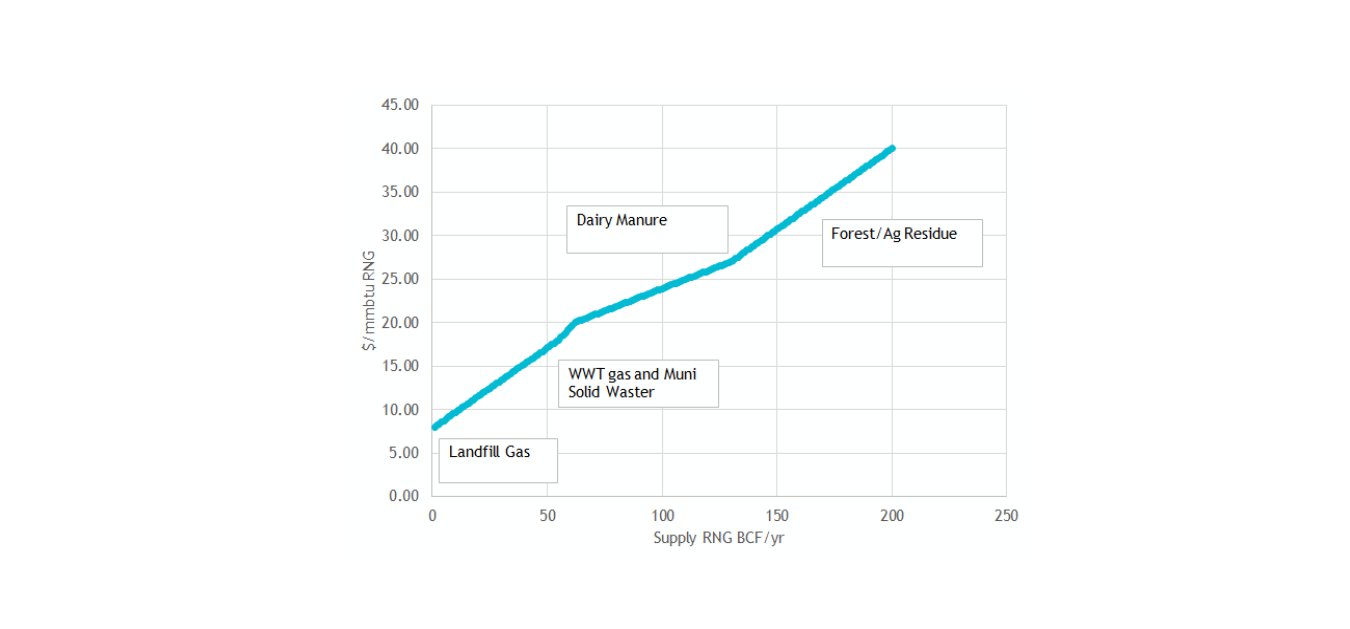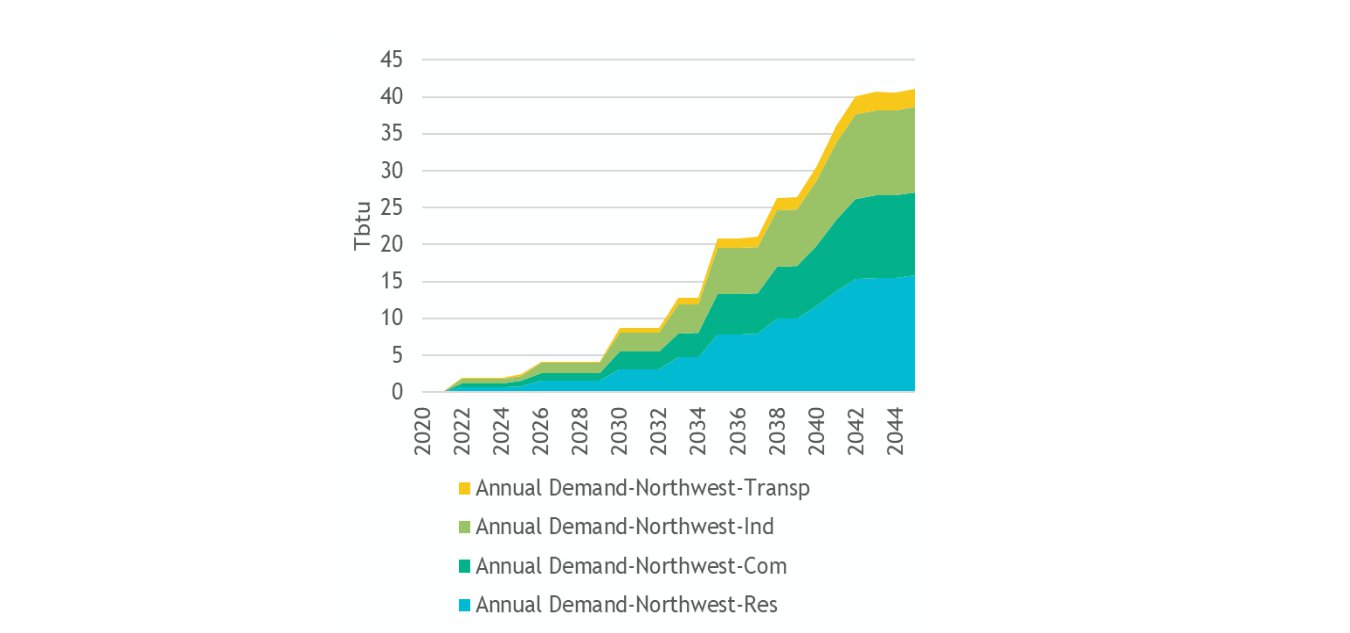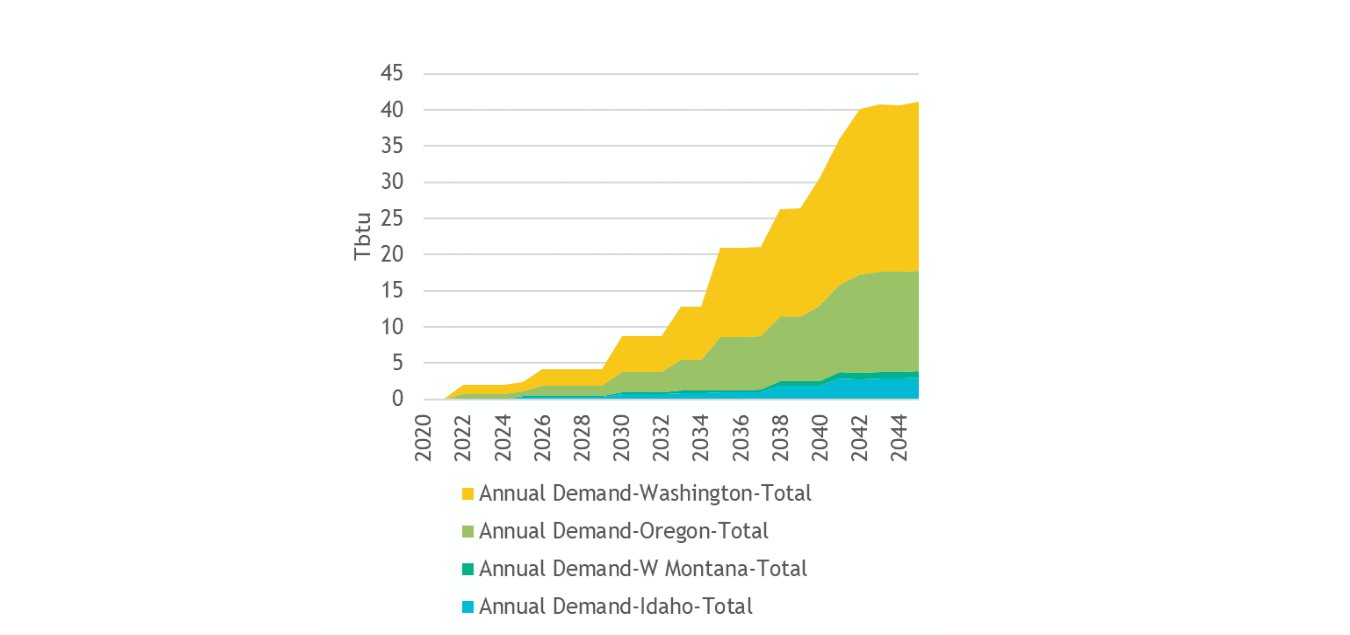The 2021 Power Plan is the first to incorporate renewable natural gas (RNG) into the planning process. We are modeling a “blended” natural gas supply as part of the power plan forecast. This “blend” reflects the impact of regional renewable natural gas (RNG) supply entering the existing natural gas pipeline system and displacing conventionally sourced fossil natural gas that is currently imported from Canada and the US Rockies.
You may find a companion workbook on RNG here.
Background
For this power plan, RNG is considered to be biogas that has been conditioned and upgraded to pipeline quality gas such that it is interchangeable with fossil gas. Biogas is a result of bacteria and other microorganisms breaking down organic material. The gas is composed mostly of methane, carbon dioxide, nitrogen, and oxygen. Biogas that is collected from waste streams from sources like garbage landfills, wastewater treatment plants, commercial and residential food waste, and agriculture dairy and other livestock farms and processed into RNG falls into the anaerobic digestion (AD) category. Biogas is roughly 62% methane with a heating value around 625 btu/scf[1]. Once it is processed and upgraded to RNG, it is around 98% methane with a heating value of 992 btu/scf.
A typical RNG project includes:
- A biogas collection system
- A processing facility
- A gas pipeline interconnection and lateral
RNG from AD processing has been used for many years now. Thermal gasification (TG) is another process which might be used in the future for producing RNG. TG is a high-heat process that breaks down biomass – such as forest and agriculture residues – into a highly flammable synthetic gas. Further processing is then required to convert this synthetic gas into usable RNG.
There have been three studies completed over the past few years which estimated the potential future supply of RNG in both the US and the Northwest. The Washington State University Energy Program and the Washington Department of Commerce completed a joint study and published results in late 2018.[2] This study quantified the potential of near and long-term projects to produce RNG for use in the region and focused on biogenic sources - anaerobic digestion of water steams from landfill, waste water treatment plants, dairy farms, and municipal food waste.
The Oregon Department of Energy completed a study of the potential inventory of RNG in Oregon for the Oregon Legislature in the fall of 2018.[3] This study included RNG from anaerobic digestion while also considering the potential of thermal gasification (TG) of agriculture and forestry residues. However, the report goes on to note that “there are currently no commercial-scale thermal gasification plants in the United States that convert biomass into methane”.
The advisory firm ICF published a study assessing RNG supply for the natural gas industry in 2019.[4] This study looked at the potential RNG supply from the entire US and for each state. In addition to anaerobic digestion and thermal gasification, the ICF study also classified the process of power to gas (P2G) as RNG. The P2G process involves the production of green hydrogen via electrolysis that is combined with a carbon source and then methanized to produce methane which can be injected into natural gas pipelines for use. For this power plan, we analyzed the potential impact of green hydrogen as a high value fuel for transportation and assumed production of hydrogen would be used in this manner and not methanized into gas for the pipeline system.
To compare the results across each of the studies, the estimates of future RNG potential by category was pulled from each report and compared to recent historic natural gas consumption levels. Annual gas consumption was queried from the US Energy Information Administration[5] and the five-year average annual value was calculated for end-use gas (Residential, Commercial, Industrial, Transportation, Distribution). The RNG supply quantities represent the long-term estimates from each study.
Natural Gas End-Use Consumption
| Region | Average Annual Consumption of Natural Gas (2016 – 2020) Res./Com./Ind./Transp./Dist. TBtu |
| US | 17,303 |
| OR | 139 |
| WA | 239 |
Long Term RNG Supply Potential
| Region | Study | Anaerobic Digestion (AD) TBtu | Thermal Gasification (TG) TBtu |
AD & TG Combined TBtu |
| US | ICF Low | 813 | 487 | 1,299 |
| US | ICF High | 1,425 | 1,714 | 3,139 |
| OR | ICF Low | 8.6 | 3.2 | 11.9 |
| OR | ICF High | 14.8 | 7.0 | 21.8 |
| OR | OR Dept. of Energy | 10.7 | 41.5 | 52.2 |
| WA | ICF Low | 13.4 | 6.3 | 19.7 |
| WA | ICF High | 23.0 | 14.6 | 37.6 |
| WA | WA Dept. of Commerce | 15.1 | - | 15.1 |
RNG Percentage of Natural Gas End Use Consumption
| Region | Study | Anaerobic Digestion (AD) % | Thermal Gasification (TG) % |
AD & TG Combined % |
| US | ICF Low | 4.7 | 2.8 | 7.5 |
| US | ICF High | 8.2 | 9.9 | 18.1 |
| OR | ICF Low | 6.2 | 2.3 | 8.5 |
| OR | ICF High | 10.6 | 5.0 | 15.7 |
| OR | OR Dept. of Energy | 7.7 | 29.8 | 37.6 |
| WA | ICF Low | 5.6 | 2.6 | 8.2 |
| WA | ICF High | 9.6 | 6.1 | 15.7 |
| WA | WA Dept. of Commerce | 6.3 | - | 6.3 |
The estimates of RNG supply from anaerobic digestion range from 4% to 10% of the current fossil natural gas consumed for end-use. When adding in the potential of thermal gasification, the lower range of the ICF study indicates a total fossil gas replacement percentage of just under 10 percent.
The cost to produce RNG depends on the biogas source and the ease of access a pipeline system and are typically much higher than the current price of fossil gas. We developed an RNG cost curve based on an ICF study on design principles for RNG.[6]
RNG Cost Curve Estimate

There are a few existing RNG facilities in the Northwest that are primarily selling the gas out of state as a transportation fuel.
One key plant is the H.W. Hill Renewable Gas Facility in Roosevelt Washington. Klickitat PUD has developed a series of biogas and now RNG projects at the Roosevelt Regional Landfill site. This is a large landfill site conveniently located near a major natural gas pipeline, Williams NW Pipeline. In July of 2020, Puget Sound Energy entered into an agreement to purchase RNG from the plant to put on their gas system[7].
The production and use of RNG can act as a companion decarbonization strategy with the electrification of end-use gas applications, or as a stand-alone strategy, as long as the process emissions are low. The end combustion of RNG emits CO2 just as fossil natural gas does. However, by collecting the waste biogas and using it to produce energy, the gas is not flared or vented directly to the environment. Also, by displacing fossil natural gas, the damaging upstream methane releases related to the extraction and transport of fossil gas is avoided. Reliable, locally sourced RNG could also help to lower gas price volatility.
Forecast & Implementation
In order to gauge the beneficial impacts of RNG for the Northwest, a time-series forecast of supply was required. Currently there is little RNG being produced and placed on the system, and of course any forecast is a very rough estimate at this point. Nonetheless, a method to forecast and implement RNG use over the planning horizon was developed.
- A judgement forecast of the percent of natural gas end-use consumption that could be met through time from locally sourced RNG was developed. The forecast was informed from the Natural Gas Advisory Committee of June 2019[8], and input from the Oregon Department of Energy and the Washington Department of Commerce. Starting from 0%, the forecast assumes Oregon and Washington would meet 9% of the end-use gas consumption with RNG by the end of the planning horizon.
- An end-use forecast of gas consumption in the residential, commercial, and industrial sectors by state was developed in our model Energy2020. The forecast of the percentage of gas consumption that would be met by RNG was applied to this forecast of gas consumption. The RNG was allocated by state, and by end-use.
- The forecast of RNG is then net from the overall gas consumption forecast in the Energy2020 model – in order to calculate the greenhouse gas emissions from the use of fossil gas and RNG.
Forecast of Renewable Natural Gas Consumption by Sector

Forecast of Renewable Natural Gas Consumption by State

[1] https://www.socalgas.com/smart-energy/renewable-gas
[2] https://www.commerce.wa.gov/wp-content/uploads/2019/01/Energy-Promoting-RNG-in-Washington-State.pdf
[3] https://www.oregon.gov/energy/Data-and-Reports/Documents/2018-RNG-Inventory-Report.pdf
[4] https://gasfoundation.org/wp-content/uploads/2019/12/AGF-2019-RNG-Study-Full-Report-FINAL-12-18-19.pdf
[6] https://www.icf.com/insights/energy/design-principles-for-renewable-gas
[7] https://www.pse.com/press-release/details/pse-signs-deal-with-klickitat-pud-to-buy-renewable-natural-gas
[8] https://www.nwcouncil.org/meeting/natural-gas-advisory-committee-june-3-2019



